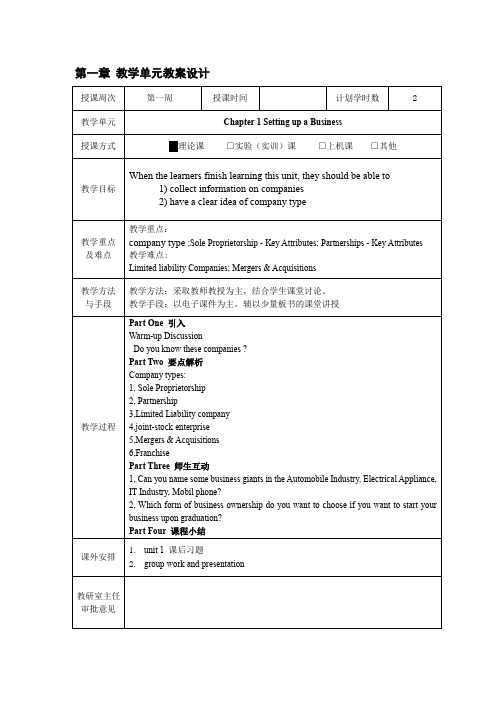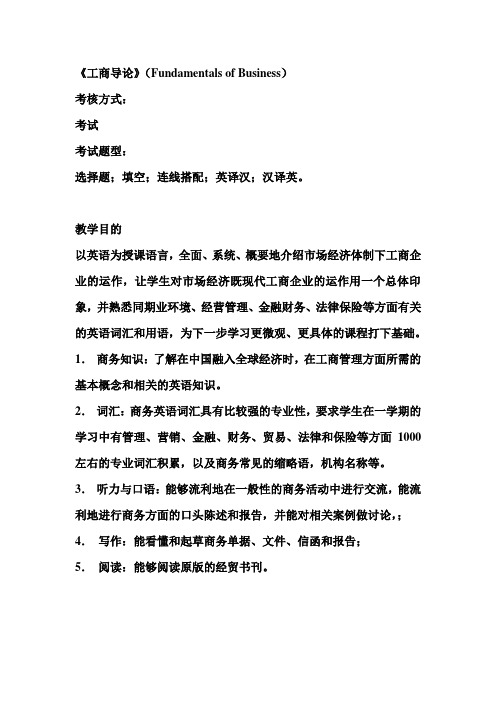工商导论Chapter 1课件
- 格式:ppt
- 大小:565.50 KB
- 文档页数:33


第一章教学单元教案设计第一章教学单元讲稿Fundamentals of Business 工商导论一,本课内容:Chapter 1 Setting up a Business课程名称:工商导论二,分析思路:1) Part One 引入Warm-up DiscussionDo you know these companies?2) Part Two 要点解析Company types:1, Sole Proprietorship2, Partnership3, Limited Liability company4, joint-stock enterprise5, Mergers & Acquisitions6, Franchise3)Part Three 师生互动1, Can you name some business giants in the Automobile Industry, Electrical Appliance, IT Industry, Mobil phone?2, which form of business ownership do you want to choose if you want to start your business upon graduation?4)Part Four 课程小结三,课程导入:Warm-up DiscussionDo you know these companies?四,教授内容一)Sole Proprietorship (个体企业)1.definitionAn organization that is owned, and usually managed, by a person or family is called sole proprietorship. It is the oldest, most common, and simplest form of business organization.Eg: neighborhood news-stand, barber house2.Sole Proprietorship - Key Attributes●Creation (minimum requirements) - No Formalities for creating a sole proprietorship.●Profits / Losses / Distributions - Owner may use all profits and losses for business.●Liability - Owner faces unlimited personal liability.●Capital / Financing - All capital obtained from owner or through loans based onowner's creditworthiness.●Management and Control - Owner manages and controls the company.●Reporting Requirements - None.3.Advantages and disadvantagesAdvantages: Can make decisions quicklyKeeps all the rewardsEasy to set upPrivacy of business affairsDisadvantages: Limited sources of financeUnlimited liability, i.e. can lose personal assetsLimited managerial skillsNo one to share workload and ideas二)Partnership (合伙制)1.DefinitionA partnership is the relationship existing between two or more persons who join to carryon a trade or business. Each person contributes money, property, labor or skill, and expects to share in the profits and losses of the business.E.g. "Big Four" accountancy firms (“四大”会计师事务所)PriceWaterhouse Coopers 普华永道会计师事务所KPMG(毕马威)是世界上最大的专业服务机构之一。



《工商导论》(Fundamentals of Business)考核方式:考试考试题型:选择题;填空;连线搭配;英译汉;汉译英。
教学目的以英语为授课语言,全面、系统、概要地介绍市场经济体制下工商企业的运作,让学生对市场经济既现代工商企业的运作用一个总体印象,并熟悉同期业环境、经营管理、金融财务、法律保险等方面有关的英语词汇和用语,为下一步学习更微观、更具体的课程打下基础。
1.商务知识:了解在中国融入全球经济时,在工商管理方面所需的基本概念和相关的英语知识。
2.词汇:商务英语词汇具有比较强的专业性,要求学生在一学期的学习中有管理、营销、金融、财务、贸易、法律和保险等方面1000左右的专业词汇积累,以及商务常见的缩略语,机构名称等。
3.听力与口语:能够流利地在一般性的商务活动中进行交流,能流利地进行商务方面的口头陈述和报告,并能对相关案例做讨论,;4.写作:能看懂和起草商务单据、文件、信函和报告;5.阅读:能够阅读原版的经贸书刊。
Set up a business and be my own bossChapter One Setting up a Business建立企业Four major forms of business:1.sole proprietorship个体经营优点:易于建立;simple to establish;决策自由;freer in decision-making;易于保守经营和财务秘密;easy to keep operational and financial secrecy税收负担较少;less tax burden独自享有利润exclusive use of profits缺点:无限责任;unlimited liability有限的资金渠道;limited access to capital有限的管理技巧limited managerial expertise2.partnership合伙企业优点:更方便得到资金和信贷;improve access to capital and credit优质管理的可能性大大增加greater possibility for good management明确的法律框架;definite legal framework更好的发展前景better prospects for growth缺点:无限责任;unlimited liability内部矛盾;internal conflict持续性问题problem of continuity3.corporation 大型股份制公司优点:有限责任;limited liability易于发展壮大;easy to expand所有权与经营权分离;separated ownership and management持续的生命力continuous life缺点:双重税收;double taxation高组织成本;high organizing costs缺少秘密;lack of secrecy特许经营4.franchise特许经营优点:顾客即刻认可;instant customer recognition自主性;independence获得培训指导;receive training and guidance借贷更容易less difficulty getting bank loans缺点:减少风险但不保证成功;reduce risk ,they do not guarantee success要牺牲部分独立性sacrifice some independence。
